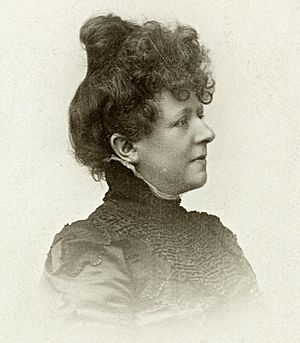Randi Blehr facts for kids
Quick facts for kids
Randi Blehr
|
|
|---|---|
 |
|
| President of the Norwegian Association for Women's Rights | |
| In office 1895–1899 |
|
| Preceded by | Ragna Nielsen |
| Succeeded by | Fredrikke Marie Qvam |
| In office 1903–1922 |
|
| Preceded by | Fredrikke Marie Qvam |
| Succeeded by | Aadel Lampe |
| Personal details | |
| Born | 12 February 1851 |
| Died | 13 June 1928 |
| Nationality | Norway |
| Political party | Liberal Party |
| Spouse | Otto Blehr |
Randi Marie Blehr (born February 12, 1851 – died June 13, 1928) was an important Norwegian woman. She worked for women's rights, peace, and political change. She was married to Otto Blehr, who became the Prime Minister of Norway. Because of this, people sometimes called her "Madam Prime Minister" (Norwegian: Statsministerinde).
Randi was one of the main leaders of the women's rights movement in Norway. She started working on this in the 1880s. She also helped create the Norwegian Association for Women's Rights. She was the president of this group for many years. She also helped start the Norwegian Women's Public Health Association. This group grew into a large organization with many members. Randi also strongly supported Norway becoming independent from Sweden.
Contents
Early Life and Interests
Randi Nilsen was born in 1851 in Bergen, Norway. She was the oldest of eleven children. Her father, Andreas Rasmussen Nilsen, was a ship broker. Her mother was Margrethe Andrea Tornøe.
Randi did not go to a formal school. But she loved art from a young age. She enjoyed drawing, theater, and music. When she was 17, she joined Vestmannalaget. This was Norway's oldest language group. She also helped create Den Nationale Scene. This is Bergen's oldest and biggest theater.
In 1876, she married Otto Blehr. He was a lawyer and a politician. He belonged to the Liberal Party. Otto later became the Prime Minister of Norway. Randi and Otto had a son named Eivind Blehr.
Fighting for Women's Rights
Randi Blehr became very involved in the women's rights movement in Norway. This happened in the 1880s. In 1883, she joined a discussion group for female students called Skuld.
A year later, in 1884, she helped start the Norwegian Association for Women's Rights. This group was called Kvindesagsforening in Norwegian. She later became the leader of this organization. She was chairperson from 1895 to 1899. She served again from 1903 to 1922.
As the leader, Randi worked hard to make life better for women. She focused on housewives and women in the working class. She asked the government to create special training courses for women. These courses would teach skills like cooking, sewing, and managing a home. Under her leadership, the group also pushed for equal pay. They also wanted children born outside of marriage to have their father legally recognized.
Other Important Work
In 1885, Randi Blehr helped start another group. It was called the Women's Suffrage Association (Kvinnestemmerettsforeningen). This group worked to give women the right to vote. She co-founded it with Gina Krog. The Norwegian Association for Women's Rights had decided not to include voting rights in their goals at that time.
A year later, in 1886, she also helped create the Norwegian Women's Public Health Association. This group was called Norske Kvinners Sanitetsforening. It focused on public health and helping people.
In 1903, Randi was chosen to lead the Norwegian Women's Peace Association. This group was called Norske Kvinners Fredsforbund. Sometimes, her husband's political work meant they had to live in Sweden. During these times, Randi took on duties as the Prime Minister's wife. She hosted events at the Norwegian government's home in Stockholm.
Recognition and Legacy
Randi Blehr received a special award on her 70th birthday in 1921. She was given the King's Medal of Merit in Gold (Kongens fortjenstmedalje). This award recognized her important work.
She passed away in 1928. She was buried at the Cemetery of Our Saviour in Oslo. Randi Blehr is remembered as a key figure in the fight for women's rights and social progress in Norway.
See also


